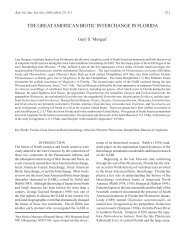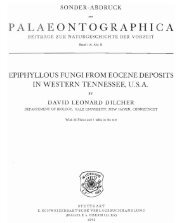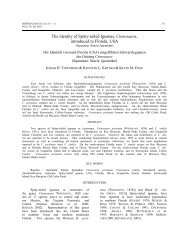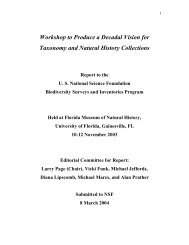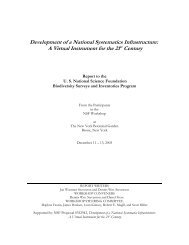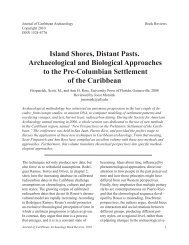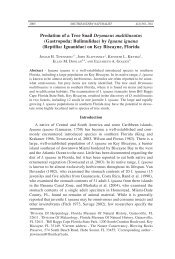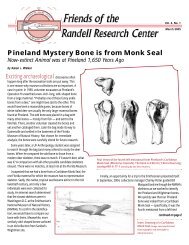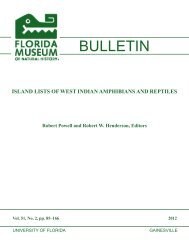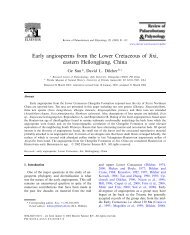COMPOSITIONAL ANALYSIS OF FRENCH COLONIAL CERAMICS ...
COMPOSITIONAL ANALYSIS OF FRENCH COLONIAL CERAMICS ...
COMPOSITIONAL ANALYSIS OF FRENCH COLONIAL CERAMICS ...
Create successful ePaper yourself
Turn your PDF publications into a flip-book with our unique Google optimized e-Paper software.
Compositional Analysis of French Colonial Ceramics Kelly et al.<br />
Bressolier et al. 1998) map, dating to the<br />
1760s.<br />
Macabou, Le Vauclin, Martinique. These<br />
sherds were collected from the surface of a<br />
site at the mouth of the bay among the<br />
mangroves. The site has Amerindian material<br />
on the surface, including faunal remains, so it<br />
is possible that it was not used to produce<br />
historic era pottery. The sherds from this site<br />
were distinct due to the presence of shell<br />
temper and were included based upon<br />
suggestion of the then-Conservator of<br />
Archaeology for Martinique, Olivier Kayser,<br />
because there may have been a kiln site there.<br />
Furthermore, we felt that if the sherds were<br />
Amerindian, they would provide a useful<br />
alternate sample for the petrography and the<br />
INAA because of different production<br />
techniques and inclusions, such as shell<br />
temper.<br />
Excavated or Non-Production Samples<br />
Habitation La Mahaudière, Anse Bertrand,<br />
Guadeloupe. These sherds came from<br />
excavated contexts dating to the late<br />
eighteenth and nineteenth century slave and<br />
laborer village site associated with a large<br />
sugar plantation.<br />
Habitation Grande Pointe, Trois Rivières,<br />
Guadeloupe. These sherds were excavated<br />
from the late eighteenth to mid nineteenth<br />
century slave village site associated with a<br />
sugar plantation.<br />
Rue Dumanoir, Basse Terre, Guadeloupe.<br />
These sherds were part of two nearly<br />
complete pitchers or carafes and a globular<br />
pot salvaged by Antoine Chancerel, then<br />
Conservator for Archaeology in Guadeloupe,<br />
from a pipeline excavation along Rue<br />
Dumanoir in the historic (seventeenth to<br />
nineteenth centuries) center of the city of<br />
Basse Terre, administrative capital of<br />
Guadeloupe. This sample was included<br />
because it resembled some very small<br />
fragments found at La Mahaudière and<br />
Grande Pointe and because they bore a strong<br />
morphological resemblance to water carafes<br />
traditionally produced in Martinique and<br />
visible on display in the Ecomusée de la<br />
Martinique, Rivière Pilote.<br />
Colonial de l’Embachure, Saint Martin,<br />
Guadeloupe. These sherds were obtained<br />
from an assemblage of between four to six<br />
nearly complete large pots that were found<br />
cached under a rock shelter on the side of one<br />
of the principle hills of the French portion of<br />
St. Martin. Other artifacts recorded with the<br />
earthenware pots suggested a late eighteenth<br />
or early nineteenth century date to the<br />
assemblage. The site has no known<br />
association with any recorded historic<br />
habitation and may represent an intentionally<br />
hidden place of refuge. The sherds were<br />
included because they were the only samples<br />
available from the island of St. Martin, a<br />
dependency of Guadeloupe.<br />
Château Dubuc, La Trinité, Martinique.<br />
These sherds were surface collected from the<br />
eighteenth to mid-nineteenth century sugar<br />
plantation.<br />
Ethnographic Collection<br />
Madame Trime, St. Anne, Martinique.<br />
These sherds were donated to our project by<br />
Madame Trime, a potter active in St. Anne.<br />
Madame Trime is believed to be the last<br />
potter working in Martinique who continues<br />
to use traditional methods, including hand<br />
building and open firing to produce<br />
earthenwares.<br />
INAA and Petrographic Methods<br />
As Mason and Keal (1988) have pointed<br />
out in south Yemen and Jordan and Schrire<br />
and Miller (1999) have demonstrated in<br />
South Africa, ceramic petrography can detail<br />
Journal of Caribbean Archaeology, Special Publication #2, 2008 93



